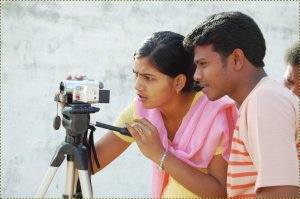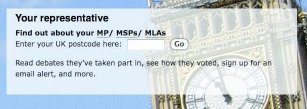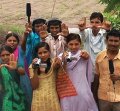TACTIC 1: VIDEO
BRING THEM TO THE ACTION
mobilise people
download this tactic card (pdf 740kb)
watch the full video
THIS TACTIC IS GOOD TO USE WHEN YOU WANT TO SUPPORT PEOPLE TO COME TOGETHER, ONLINE AND IN PERSON, AROUND A CAUSE
EXAMPLES FROM THE VIDEO
|
|
Citizen journalists in India
TOOLS USED: Digital video cameras, editing software, YouTube, widescreen projectors, VCD/DVDs for video screenings in villages and to community networks.
LINKS TO LEARN MORE: |
|
|
Women's advocates in India
TOOLS USED: Facebook, Blogspot, Flickr, posters, digital cameras.
LINKS TO LEARN MORE: |
- Using a Friendless Profile for Visibility
TOOLS USED: Facebook.
LINKS TO LEARN MORE:
Creating a Facebook profile
TACTIC 1: PLAN YOUR ACTION
BRING THEM TO THE ACTION
mobilise people
download this tactic card (pdf 740kb)

VIDEO VOLUNTEERS
Plan your action
- These campaigns blend digital information with in-person action: projecting videos made by advocates in India in their villages as well as online, or sharing photos of the many pairs of pink panties mailed in protest on the campaign's blog and on social network site profiles.
- If you want to use a social network site like Facebook or Orkut to gather supporters, you may face challenges in sending mass messages to all of them at once. Plan for other ways to collect people's contact information so that you can also message people outside the social network site.
- Using humour or surprise can help to get people's attention and can increase the chances that they will spread your call to action to their friends. Hearing about your campaign from social network site friends can make your issues more personal and easier to relate to.
- When asking people to submit photos or videos as part of the action itself, as with the Pink Chaddi campaign, be mindful of communicating clearly with them how these images will be used. This can be especially important if you draw media attention to your campaign.
- Consider how you can monitor the reach of your campaign, including how people understand and respond to your message or call to action. Video Volunteers use an outreach volunteer to contextualise their media to target audiences and offer workshops with their screenings.
Do it yourselfAsk
- Is there a timely event or news hook you can use to draw more people’s attention to your action?
- What is the simplest symbol or visual you could use for your campaign that would encourage people to spread your message, and how will you let people personalise this?
- Does your action communicate with the people who have the power to make the direct change you seek (your target), or with the people you can mobilise to influence your target?
- How can you capitalise on the attention you already have from people on your website, or on social network sites, to direct them to take an action?
- What is the easiest way for people to spread your message: on social network sites, by email or by text message, by in-person gatherings, by phone calls?
Different ways you can do this
- Create a short slogan that is easy to translate. Ask people to photograph themselves holding a sign with the slogan in their own language and send you the photo to share on your website or in a video or slideshow.
- Make a profile or a fan page on a social network site to parody a public figure you seek to influence, and ask supporters to become friends with this profile. But be aware of who has ownership over content created in groups you establish on commercial websites and consider who will own contact details of people that become group members.
- Host a competition for short videos about your issue and ask people to vote on their favourites. Host screenings of the winning videos in-person and online. You can hold a screening in a public building and invite local media.
- If you don’t already have a list of contacts interested in your campaign, partner with an organisation that sends out emails to its supporters and ask them to direct its members towards your action.
- If supporters must remain anonymous, you can make this anonymity part of your campaign imagery: for example, by asking people for photos of their hands or feet, or of objects that can become symbolic of an issue. You can then use these images in your campaign.
|
FEATURED TOOL Collaborate on a photo slideshow |
TIPS NAMITA SINGH, VIDEO VOLUNTEERS, ON YOUR CALL TO ACTION: "There is no campaign without an action. So one piece of advice is to have a really strong and meaningful call to action, which gets people to do something. Also consider that the actions of one village can be used to inspire people in other villages to speak out, so be sure to share your success stories."
REBECCA SAAB SAADE, TECHNOLOGIST, ON RISK AND DISCLOSURE: "I would advise anyone working on sensitive issues to think of their target group first, media second. Closed societies tend to have strong word-of-mouth kind of communication. Addressing public opinion comes later. In order to mobilise people you need to understand that even if you don’t mind being vocal and visible, others do. If you promised you won’t compromise people’s privacy, then you never should or they won’t trust you anymore. So study the people you are working for, think of what message needs to get across, then think of what media to use."
NAMITA MALHOTRA, ALTERNATIVE LAW FORUM, ON USING ONLINE TOOLS FOR OFFLINE ACTION: "Online activism is a fairly new phenomenon in India. What was so unique about the Pink Chaddi campaign is that it used online tools to ask people to take an action offline. There were various problems with the online activism that made it difficult to translate into an offline mode and one of them was the fact that it was on facebook." |
TACTIC 1: CASE STUDY
BRING THEM TO THE ACTION
mobilise people
download this tactic card (pdf 740kb)


Case Study
| TITLE: WHO: WHERE: WEBSITE: |
TheyWorkForYou MySociety UK www.TheyWorkForYou.com |
DESCRIPTION
In 2009, MySociety launched a campaign which supported voters in the UK to send emails to their Members of Parliament (MP), demanding transparency in the use of public funds. "We send tens of thousands of email alerts every day to readers of our website TheyWorkForYou.com" says Tom Steinberg of MySociety. Each email gives a link to a website, where people can find their MP and write him or her a custom email. After sending the email, people are invited to join a Facebook group, which, when they join, will post a link in their Facebook profile to publicise their own email campaign. In 2009 the government sought to have MPs' expenses claims kept secret, despite successful Freedom of Information requests. TheyWorkForYou mobilised people to demand transparency. Tom says, "Whether our email campaign was decisive in influencing Parliament, we'll never know, with Parliament being so secretive. But we were able to send a few thousand emails to MPs about this issue. It might not sound like a lot, but these were all individual messages from constituents that went to 95% of MPs. Extremely targeted emails have got to be the most effective form of email campaigns." Soon after this campaign, the UK government agreed to disclose data on MP expenses.
| TOOLS USED: | Custom-built content management system (CMS) and contact management system made from open source software components was used to make TheyWorkForYou. Wordpress and Facebook were also used for the MP expenses campaign. |
| REACH: | The campaign was focused on UK citizens and politicians. The website had 500,000 visitors the month the story broke in the UK press, and it receives an average of 250,000 visitors per month. |
| RESOURCES: | Web hosting donated. |
| TIME: | From planning to completion, the MP expenses campaign took five days. The CMS was already developed and installed. |
LEVEL Of DIFFICULTY: 2 with contact management tools in place, 4 if you must develop them.
COST: USD$1700 in staff salary to run the campaign.
LINKS TO LEARN MORE:
About the campaign effectiveness: UNO NOTICIAS website, Write To Them website statistics
About MySociety


